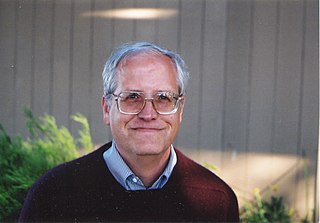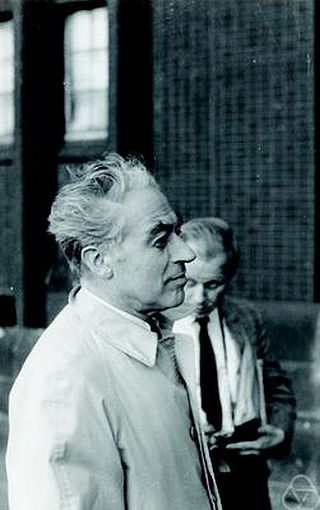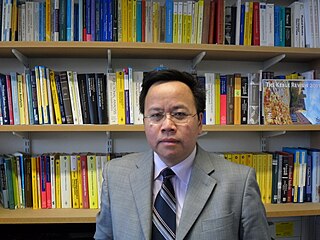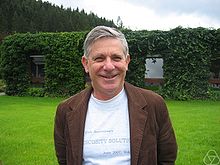
John Forbes Nash, Jr., known and published as John Nash, was an American mathematician who made fundamental contributions to game theory, real algebraic geometry, differential geometry, and partial differential equations. Nash and fellow game theorists John Harsanyi and Reinhard Selten were awarded the 1994 Nobel Memorial Prize in Economics. In 2015, he and Louis Nirenberg were awarded the Abel Prize for their contributions to the field of partial differential equations.

Lars Valter Hörmander was a Swedish mathematician who has been called "the foremost contributor to the modern theory of linear partial differential equations". Hörmander was awarded the Fields Medal in 1962 and the Wolf Prize in 1988. In 2006 he was awarded the Steele Prize for Mathematical Exposition for his four-volume textbook Analysis of Linear Partial Differential Operators, which is considered a foundational work on the subject.

Cathleen Synge Morawetz was a Canadian mathematician who spent much of her career in the United States. Morawetz's research was mainly in the study of the partial differential equations governing fluid flow, particularly those of mixed type occurring in transonic flow. She was professor emerita at the Courant Institute of Mathematical Sciences at the New York University, where she had also served as director from 1984 to 1988. She was president of the American Mathematical Society from 1995 to 1996. She was awarded the National Medal of Science in 1998.

The Courant Institute of Mathematical Sciences is the mathematics research school of New York University (NYU). Founded in 1935, it is named after Richard Courant, one of the founders of the Courant Institute and also a mathematics professor at New York University from 1936 to 1972, and serves as a center for research and advanced training in computer science and mathematics. It is located on Gould Plaza next to the Stern School of Business and the economics department of the College of Arts and Science.

Jürgen Kurt Moser was a German-American mathematician, honored for work spanning over four decades, including Hamiltonian dynamical systems and partial differential equations.

Hans Lewy was an American mathematician, known for his work on partial differential equations and on the theory of functions of several complex variables.

Louis Nirenberg was a Canadian-American mathematician, considered one of the most outstanding mathematicians of the 20th century.

Luis Ángel Caffarelli is an Argentine-American mathematician. He studies partial differential equations and their applications.

Richard Melvin Schoen is an American mathematician known for his work in differential geometry and geometric analysis. He is best known for the resolution of the Yamabe problem in 1984.

Lawrence Craig Evans is an American mathematician and Professor of Mathematics at the University of California, Berkeley.
In mathematics, a (real) Monge–Ampère equation is a nonlinear second-order partial differential equation of special kind. A second-order equation for the unknown function u of two variables x,y is of Monge–Ampère type if it is linear in the determinant of the Hessian matrix of u and in the second-order partial derivatives of u. The independent variables (x,y) vary over a given domain D of R2. The term also applies to analogous equations with n independent variables. The most complete results so far have been obtained when the equation is elliptic.
Lloyd Nicholas Trefethen is an American mathematician, professor of numerical analysis and head of the Numerical Analysis Group at the Mathematical Institute, University of Oxford.

Leon Melvyn Simon, born in 1945, is a Leroy P. Steele Prize and Bôcher Prize-winning mathematician, known for deep contributions to the fields of geometric analysis, geometric measure theory, and partial differential equations. He is currently Professor Emeritus in the Mathematics Department at Stanford University.
Xu-Jia Wang is a Chinese-Australian mathematician. He is a professor of mathematics at the Australian National University and a fellow of the Australian Academy of Science.

Andrew Joseph Majda was an American mathematician and the Morse Professor of Arts and Sciences at the Courant Institute of Mathematical Sciences of New York University. He was known for his theoretical contributions to partial differential equations as well as his applied contributions to diverse areas including shock waves, combustion, incompressible flow, vortex dynamics, and atmospheric sciences.

David Gilbarg was an American mathematician, and a professor emeritus at Stanford University.

Gui-Qiang George Chen is a Chinese-born American-British mathematician. Currently, he is Statutory Professor in the Analysis of Partial Differential Equations, Director of the Oxford Centre for Nonlinear Partial Differential Equations, and Director of the EPSRC Centre for Doctoral Training in Partial Differential Equations at the Mathematical Institute, and Professorial Fellow at Keble College, located at the University of Oxford, as well as Life Member of Clare Hall, University of Cambridge.
Nicolai Vladimirovich Krylov is a Russian mathematician specializing in partial differential equations, particularly stochastic partial differential equations and diffusion processes. Krylov studied at Lomonosov University, where he in 1966 under E. B. Dynkin attained a doctoral candidate title and in 1973 a Russian doctoral degree. He taught from 1966 to 1990 at the Lomonosov University and is since 1990 a professor at the University of Minnesota. At the beginning of his career he, in collaboration with Dynkin, worked on nonlinear stochastic control theory, making advances in the study of convex, nonlinear partial equations of 2nd order, which were examined with stochastic methods. This led to the Evans-Krylov theory, for which he received with Lawrence C. Evans in 2004 the Leroy P. Steele Prize of the American Mathematical Society. They proved the second order differentiability of the solutions of convex, completely nonlinear, second order elliptical partial differential equations and thus the existence of "classical solutions". He was in 1978 at Helsinki and in 1986 at Berkeley an invited speaker for the ICM. He received the Humboldt Research Award in 2001. In 1993 he was elected a member of the American Academy of Arts and Sciences (1993). He should not be confused with the mathematician Nikolay M. Krylov.

Michael Grain Crandall is an American mathematician, specializing in differential equations.

Gaven John MartinFRSNZFASLFAMS is a New Zealand mathematician. He is a Distinguished Professor of Mathematics at Massey University, the head of the New Zealand Institute for Advanced Study, the former president of the New Zealand Mathematical Society, and former editor-in-chief of the New Zealand Journal of Mathematics. He is a former Vice-President of the Royal Society of New Zealand [Mathematical, Physical Sciences Engineering and Technology. His research concerns quasiconformal mappings, regularity theory for partial differential equations, and connections between the theory of discrete groups and low-dimensional topology.















